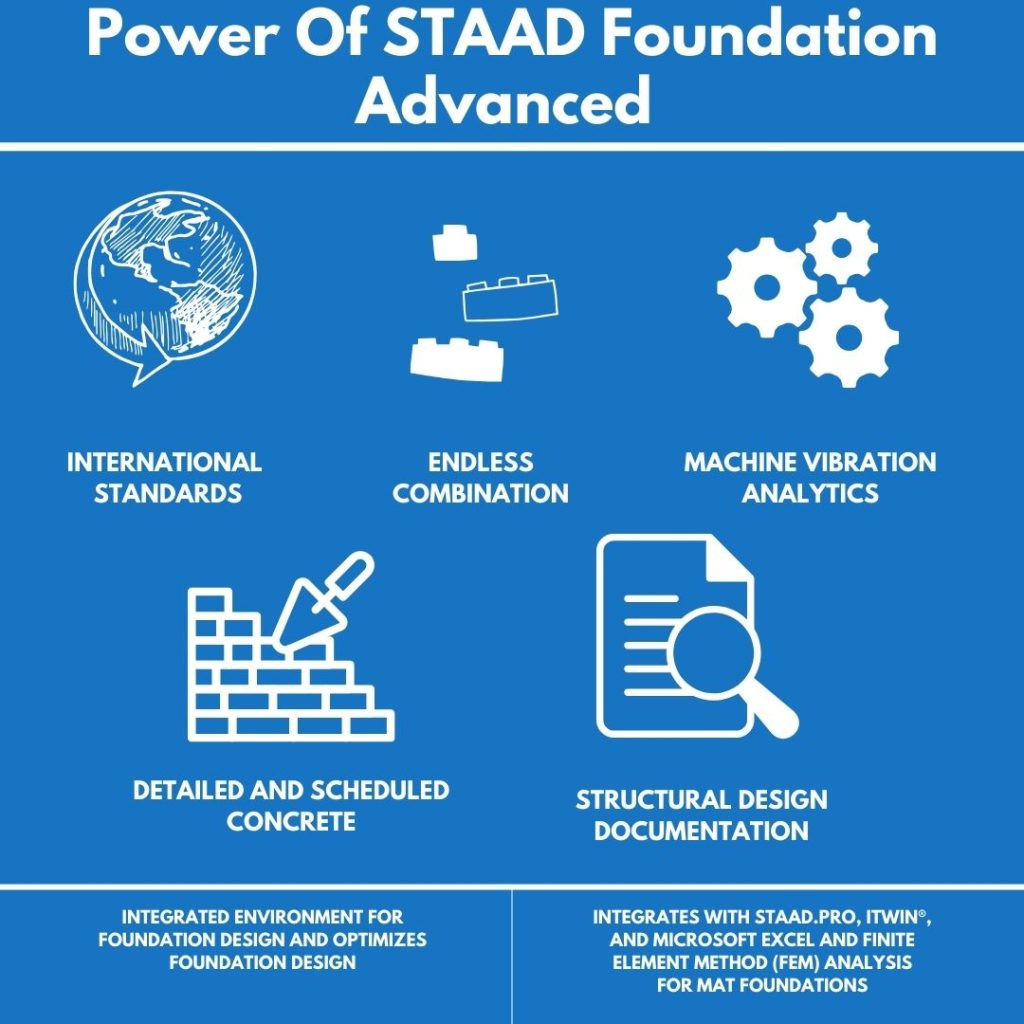WHAT IS STAAD FOUNDATION ADVANCED?
STAAD Foundation Advanced stands as an inclusive software solution for structural foundation design and analysis, equipped with specialized features tailored to various foundation types. Users can conduct analyses for isolated, combined, pile cap, and mat foundations, as well as more intricate foundation structures like horizontal vessel foundations, tank annular ring walls, lateral analysis of pile/drilled piers, and vibrational analysis for machine foundations.

The software provides three modes of operation – a general mode for superstructure data imported from STAAD.Pro® or Microsoft Excel or is user-specified; a plant mode for vertical and horizontal vessels, and self as well as mechanically anchored tanks; and a wizard-based mode for quick and easy data input for simple foundation types. The foundation types that can be designed include isolated and combined footings, pilecaps, mat foundations, and annular ring wall foundations for self and mechanically anchored tanks. Other capabilities include analysis of drilled piers for vertical and lateral loads, vibration analysis for machine foundations, automatic load (wind and seismic) generation for vessel structures, and load combination generation capabilities. Output of the designs is presented in the form of calculation reports with footing sketches, graphs, and references to the relevant sections of the design codes.
STAAD Foundation Advanced supports a number of concrete codes: ACI 318 (2019 – for mats only, 2014, 2011, and 2005 editions), Indian IS-456-2000, Eurocode EN 1992-1-1-2004, Australian AS3600-2018, Chinese GB 50007-2011, Canadian A23.3-2019, and BS-8110. The PIP STC 01015 code is implemented for equipment foundation load generation and the API 650 and ACI 351.3R-04 standards are used for tank foundations and machine foundation vibration analysis. Checks performed include determination of the overall safety from the standpoint of soil-bearing pressures, overturning and sliding stability, flexure, one-way and two-way shear limit states for concrete, pedestal design, and more. The adequacy of existing foundations of known sizes can be checked, and the software can recommend optimal sizes for some of those foundation types. The program’s graphical capabilities enable engineers to view displaced shapes, stress and moment contours, soil pressures, and reinforcement layout.
STAAD Foundation Advanced is tightly integrated with STAAD.Pro. Other modes of data exchange include iTwin and Microsoft Excel. A STAAD.Pro file that is successfully analyzed can be imported into or exported to STAAD Foundation Advanced, while automatically bringing in all column positions (and/or plates), column cross section dimensions, support reactions, and loads. Changes made to the column positions or loads can be re-imported to re-evaluate the substructure designs. Data exchange through Microsoft Excel consists of import and export of input data and export of detailed output.
For mat foundations, STAAD Foundation Advanced provides a physical object-based modeling environment that offers a great deal of flexibility in terms of the kind of mat geometries that can be created – irregular shapes, thickened regions, and openings of various shapes. A built-in mesh generator simplifies the task of generating a STAAD.Pro finite element (FE) mathematical model with automatic generation of compression-only spring supports for soils and springs for piles. Physical loading objects facilitate quick and easy methods for creating irregular area loads, circular line/area loads, quadrilateral loads, straight line loads, and point loads on space. The FE model is analyzed using STAAD.Pro’s analysis engine. In uplift situations, the area of the mat in contact with the ground is included in the output. The software performs checks for flexure and punching shear, and recommends reinforcement bar sizes and spacing. Capacity checks for user-specified bar arrangements are also available. For machine foundations, STAAD Foundation Advanced generates solid elements and dynamic loads based on user input. These too are analyzed using the STAAD.Pro analysis engine. Checks on deflections and comparisons of frequencies as per the ACI 351.3R are also performed.
STAAD Foundation Advanced generates drawings for plan, elevation, and sectional views with rebar marks. Schedule drawings provide a summary table for design results. GA drawings include all the footings designed in the project with grid lines and grid marks that help identify interference. Drawings can be exported to DXF or DWG formats.

Contact Us
SOHO Pancoran, South Jakarta
Block Splendor Wing, 28th Floor
Unit S-2803, South Jakarta, 12810
